PBS News: September16-22, 2019
DW Documentary: Coca-Cola’s plastic secrets
NatureNorth: From Egg to Frog in 7 Weeks!
4 Ever Green: 10 Most Beautiful Butterflies on Planet Earth
Biju Varkey: Butchart Gardens, Pocket Worthy: 22,000 Days Without Drinking Water and Physics Explains Why Time Passes Faster As You Age
TED Talks: Megan Phelps Roper I Grew up in the Westboro Baptist Church Here is Why I Left and Jonathan Haidt can a Divided America Heal
Thisiscolossal: An Incredible Aerial Tour of Earth’s Surface from the International Space Station and Fantastical Photographs of Opulently Dressed Models in Castles and Mansions
Ing’s Peace Project: Salon Creative Lounge Event, presented by the International Women Artist’ salon,154 Stanton Street at Suffolk, New York City, NY
PBS NewsHour Weekend live show September 22, 2019
•Streamed live 4 hours ago
PBS NewsHour 1.39M subscribers
On this edition for Sunday, September 22, President Trump hits the road as international issues take center stage, the General Motors strike enters its second week, and a look at what Peru is doing to reform a gold-mining industry that has decimated part of the Amazon rain forest. Megan Thompson anchors from New York.
PBS NewsHour Weekend live show September 21, 2019
Streamed live 4 hours ago
1.38M subscribers
On this edition for Saturday, September 21, the U.S. says it will provide “defense support” to Saudi Arabia, young people take the lead on climate change at the Youth Climate Summit, and Peru’s government cracks down on gold mining in the Amazon. Megan Thompson anchors from New York. Stream your PBS favorites with the PBS app: https://to.pbs.org/2Jb8twG Find more from PBS NewsHour at https://www.pbs.org/newshour Subscribe to our YouTube channel: https://bit.ly/2HfsCD6 Follow us: Facebook: https://www.pbs.org/newshour Twitter: https://www.twitter.com/newshour Instagram: https://www.instagram.com/newshour Snapchat: @pbsnews Subscribe: PBS NewsHour podcasts: https://www.pbs.org/newshour/podcasts Newsletters: https://www.pbs.org/newshour/subscribe
Category News & Politics
PBS NewsHour full episode September 20, 2019
•Published on Sep 20, 2019
Friday on the NewsHour, new details are being reported about a whistleblower complaint that might involve President Trump. Plus: Severe floods in southeastern Texas, the world’s largest climate change demonstrations, why Three Mile Island is closing, political analysis from Shields and Brooks and the movie premiere of the beloved “Downton Abbey.” Stream your PBS favorites with the PBS app: https://to.pbs.org/2Jb8twG Find more from PBS NewsHour at https://www.pbs.org/newshour Subscribe to our YouTube channel: https://bit.ly/2HfsCD6
PBS NewsHour full episode September 19, 2019
Published on Sep 19, 2019
Thursday on the NewsHour, Rep. Adam Schiff weighs in on an “urgent” whistleblower complaint that’s causing a standoff between the White House and Congress. Plus: Fallout from Canadian Prime Minister Justin Trudeau’s blackface scandal, the Senate GOP’s gun policy ideas, rising costs of Guantanamo Bay, economic risks of a climate crisis, a Native voice in poetry and connecting through portraiture. WATCH TODAY’S SEGMENTS: News Wrap: Iran threatens ‘all-out war’ if attacked by U.S. https://www.youtube.com/watch?v=SDXTf… Schiff says ‘we’re at risk’ over handling of whistleblower https://www.youtube.com/watch?v=EJssW… For many Canadians, Trudeau blackface photos come as a shock https://www.youtube.com/watch?v=4NT4B… Public pressure on guns galvanizes Senate GOP, despite Trump https://www.youtube.com/watch?v=R6s2A… Why cost of holding prisoners at Guantanamo Bay keeps rising https://www.youtube.com/watch?v=9lDKI… Why extreme climate scenarios no longer seem so unlikely https://www.youtube.com/watch?v=Cu3Wo… Poet laureate Joy Harjo opens a Native ‘doorway of hope’ https://www.youtube.com/watch?v=cOArJ… Toyin Ojih Odutola on connecting through portraiture https://www.youtube.com/watch?v=9N3XM…
PBS NewsHour full episode September 18, 2019
Published on Sep 18, 2019
Wednesday on the NewsHour, the Fed cuts its benchmark interest rate for the second time in three months to keep the economy growing. Plus: Will attacks on Saudi oil sites prompt a U.S. military response, Calif. Gov. Gavin Newsom on President Trump’s change to emissions rules, Maine lobsters suffer in warming waters, mining sand in Cambodia, teens on vaping dangers and a special retirement message. WATCH TODAY’S SEGMENTS: News Wrap: Israel’s government in limbo after close election https://www.youtube.com/watch?v=1anGV… How U.S. economists have driven growth-oriented policy https://www.youtube.com/watch?v=bHaVb… What attacks on Saudi oil sites mean for the U.S. and Iran https://www.youtube.com/watch?v=6DbIN… Calif. Gov. Gavin Newsom on changes to auto emission rules https://www.youtube.com/watch?v=Di5uj… How rising water temperatures could end Maine’s lobster boom https://www.youtube.com/watch?v=1iCrL… How sand mining is threatening Cambodia’s Mekong River https://www.youtube.com/watch?v=Tmyhe… How teens are reacting to news of vaping dangers https://www.youtube.com/watch?v=CAFw9… A special retirement message for beloved teacher Mr. Moe https://www.youtube.com/watch?v=QsIQA…
PBS NewsHour full episode September 17, 2019
•Published on Sep 17, 2019
Tuesday on the NewsHour, former Trump campaign manager Corey Lewandowski testifies before the House Judiciary Committee — but doesn’t say much. Plus: What’s at stake in Israel’s second election of the year, Texas gun owners talk about universal background checks and red flag laws, how government detention can hurt children and remembering journalist and beloved NewsHour friend Cokie Roberts. WATCH TODAY’S SEGMENTS: News Wrap: Taliban attacks kill at least 48 in Afghanistan https://www.youtube.com/watch?v=gOUR0… What Democrats and Republicans took from Lewandowski hearing https://www.youtube.com/watch?v=7E_4B… 2nd election, corruption charges place Netanyahu in jeopardy https://www.youtube.com/watch?v=OG6FJ… How Texas gun owners feel about these reform ideas https://www.youtube.com/watch?v=-afcR… How detention centers deepen migrant children’s trauma https://www.youtube.com/watch?v=mJ7vE… Linda Wertheimer and Nina Totenberg remember Cokie Roberts https://www.youtube.com/watch?v=OF1Lb…
PBS NewsHour full episode September 16, 2019
Published on Sep 16, 2019
Monday on the NewsHour, a strike by 50,000 General Motors workers at plants across the country puts the brakes on production. Plus: Airstrikes on two major Saudi oil fields increase U.S. tension with Iran, Israelis go to the polls for the second time in a year, Politics Monday, the first woman of color on network late-night TV and an artist’s brief but spectacular take on his unique visual medium. WATCH TODAY’S SEGMENTS: News Wrap: Purdue Pharma files for bankruptcy protection https://www.youtube.com/watch?v=zgcPM… What’s at stake for GM and other automakers with UAW strike https://www.youtube.com/watch?v=4XAvO… Will reaction to Saudi oil attacks ‘spiral out of control’? https://www.youtube.com/watch?v=vyAkd… How 2nd election could reshape Israel’s political landscape https://www.youtube.com/watch?v=xde9D… Stu Rothenberg and Domenico Montanaro on gun policy in 2020 https://www.youtube.com/watch?v=fJJ8g… How Lilly Singh is making late-night TV history https://www.youtube.com/watch?v=hZuE0… Visual artist Angel Otero on discovering his creative voice https://www.youtube.com/watch?v=pfP4c… Stream your PBS favorites with the PBS app: https://to.pbs.org/2Jb8twG Find more from PBS NewsHour at https://www.pbs.org/newshour Subscribe to our YouTube channel: https://bit.ly/2HfsCD6 Follow us: Facebook: https://www.pbs.org/newshour Twitter: https://www.twitter.com/newshour Instagram: https://www.instagram.com/newshour Snapchat: @pbsnews Subscribe: PBS NewsHour podcasts: https://www.pbs.org/newshour/podcasts Newsletters: https://www.pbs.org/newshour/subscribe
Category News & Politics
Coca-Cola’s plastic secrets | DW Documentary
Published on Sep 19, 2019
By 2050, there could be more plastic than fish in the sea. Ten tons of plastic are produced every second. Sooner or later, a tenth of that will end up in the oceans. Coca-Cola says it wants to do something about it – but does it really? In January 2018, Coca-Cola made an ambitious announcement: The brand, which sells 120 billion plastic bottles every year, promised a “world without waste” by 2030. But filmmaker Sandrine Rigaud was skeptical about this ostensibly noble resolution. In Tanzania, for example, far from the company’s American headquarters, a different picture emerges. Here everyone waits for red-and-white buses and walks by red-and-white walls, and the children play with red-and-white equipment in the playgrounds. The Coca-Cola logo is ubiquitous. But what is even more worrying is that history is repeating itself here. As it did 50 years ago in the United States, Coca-Cola has been continuously replacing glass bottles with plastic ones since 2013. Coca-Cola Vice President Michael Goltzman tries to play down the problem, saying it’s not the plastic bottles themselves that are the problem, but the lack of suitable infrastructure in Tanzania. ——————————————————————– DW Documentary gives you knowledge beyond the headlines. Watch high-class documentaries from German broadcasters and international production companies. Meet intriguing people, travel to distant lands, get a look behind the complexities of daily life and build a deeper understanding of current affairs and global events. Subscribe and explore the world around you with DW Documentary. Subscribe to DW Documentary: https://www.youtube.com/channel/UCW39… Our other YouTube channels: DW Documental (in spanish): https://www.youtube.com/dwdocumental DW Documentary ??????? ?? ?????: (in arabic): https://www.youtube.com/dwdocarabia For more documentaries visit also: https://www.dw.com/en/tv/docfilm/s-3610 Instagram https://www.instagram.com/dwdocumentary/ Facebook: https://www.facebook.com/dw.stories DW netiquette policy: https://p.dw.com/p/MF1G
Category Education
From Egg to Frog in 7 Weeks!
•Published on Apr 13, 2014
The development of Wood Frog (Lithobates sylvaticus) eggs to froglets in 49 days, just 7 weeks!
Category Education
10 Most Beautiful Butterflies on Planet Earth
•Published on Jul 15, 2019
These cute and colorful creatures known as Butterflies are heart of our beautiful nature and it is very important that we keep these beautiful insects highlighted. These wonderful creatures have hundreds of species and names but I have listed only 10 of the most beautiful ones that are appealing to me. You can comment which one you like the most and why. Subscribe To Our Channel : https://bit.ly/4EverGreen More Videos About Colorful Animals You Won’t Believe Actually Exist: Beautiful Insects: https://youtu.be/7HYj798vyM8 Beautiful Fishes: https://youtu.be/YXPQmr-S9Uk Beautiful Frogs: https://youtu.be/9k1hNqP4vmw Beautiful Snakes: https://youtu.be/mnuxdYwtxm0 Our Social Media: Facebook: https://www.facebook.com/4EGYT Twitter: https://twitter.com/4EverGreens Google+:https://plus.google.com/+fourevergreen For more videos and articles visit our website: https://www.4evergreen.org/ For Any Copyright Concerns, Contact Us at our email address. We will act upon your query immediately.
Category Pets & Animals
Butchart Gardens
Published on Oct 23, 2017
The Butchart Gardens is a group of floral display gardens in Brentwood Bay, British Columbia, Canada, located near Victoria on Vancouver Island. The gardens receive close to a million visitors each year. Gears Used Zhiyun Crane v2 https://zhiyun.us/collections/all Sony PXWX70 4K https://pro.sony.com/bbsc/ssr/micro-x… Nikon D800E Nikon AF-S 24-70mm f/2.8G ED www.onreviews.ca
Category Travel & Events
https://getpocket.com/explore/item/22-000-days-without-drinking-water?utm_source=pocket-newtab
Pocket Worthy:
·Stories to fuel your mind.
22,000 Days Without Drinking Water
Bolivia’s populist president has vowed to lift the fortunes of the rural poor. But high on the Andean plateau, one remote community still has no access to clean water—and one man has the awesome responsibility of ensuring his people are not parched.
Narratively | Michele Bertelli, Felix Lill, and Javier Sauras

Photos by Javier Sauras
It’s almost seven o’clock in the morning. The thermometer does not dare to peek above thirty degrees Fahrenheit but the sun bites every time it manages to find its way through the clouds of the high Andean plateau. Jacinto Sirpa, a peasant and member of the Aymara indigenous community, pulls down his camouflage hat over a woolen cap. Everything about him has the flavor of the Earth: chestnut coat, gray trousers, brown sneakers; a pair of beige gloves protects his copper hands while he ropes his old donkey, loaded with four large empty drums. Sirpa focuses his umber eyes, surrounded by wrinkles, on a distant barren slope and starts walking. He has to reach the slope, one hour walking from his home, to get some water. Just as he has done throughout his entire life. The same journey he has been repeating for sixty years now; 22,000 days without clean drinking water.
“I have never had drinking water,” says the farmer, shyly. “I have never drunk clean water.”
Jacinto Sirpa Condori is not one of a kind. Two million people don’t have drinking water piped into their houses in Bolivia and half of the population lacks basic sanitation. Sirpa lives in a rural community that is within the city of Viacha, two hours from La Paz, the capital. Despite living so close to the Presidential palace, Sirpa’s life is harsh. At 13,000 feet above sea level, even oxygen is a scarce resource.
***
The sun shines high in the sky, and Sirpa is back in his house of mud and straw. Using a colander, he filters the water he just brought from the pond and prepares coca tea. Sirpa knows better than anyone that the liquid he collects daily in the wetlands is not potable. His loneliness says so.

Jacinta Sirpa on his way to his only source of water – through a barren landscape, an hour away from home.
“These days my wife is sick, my children are sick; it seems that the land is also tired and no longer bears good fruits,” he says in a sad voice. Quiet, with simple and smooth movements, he pours the mate tea on the ground before taking a small mouthful. It is an offering to the Pachamama goddess so that she may look kindly upon him. “Hopefully, one day we will have water, and maybe we could irrigate and sow the fields. Do something.”
Sirpa believes in indigenous reciprocity towards Mother Earth, to whom he always gives something when there is something that he takes. However, these days he prefers to ask government institutions to address his problem of water scarcity rather than praying to the goddess. After leading the cattle to graze, the farmer uses one of the drums to wash himself. Then, he slithers into a red-and-black poncho, takes his ceremonial instruments and changes the camouflage hat out for a dark fedora. This year he has been appointed “Uma Mallku” of his community: overseer of the waters. In the Aymara society, Mallkus are rotating positions, their holder charged with ensuring the community has enough water. From a shack, he pulls out two large, rolled-up sheets, with documents and drawings, and gets back on track, crossing the infinite vastness of the “Altiplano.”
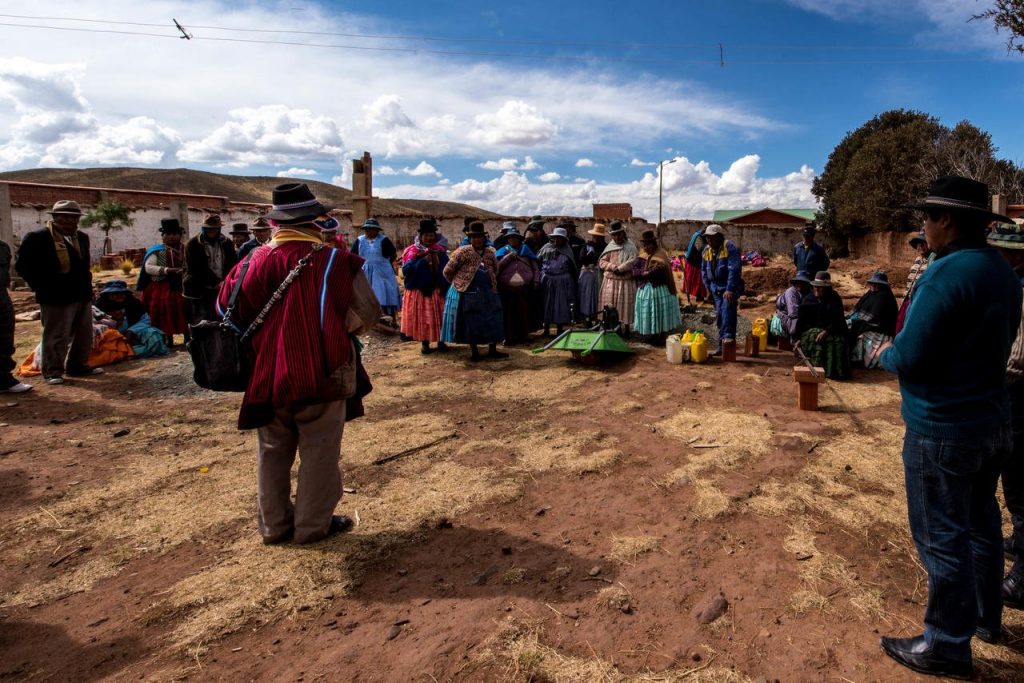
Sirpa speaking to the community. As the Uma Mallku, or Overseer of Water, he listens to the community’s concerns, writes down their suggestions and takes them to the local authority. Then, he will come back with answers from the officials.
“Governmental institutions don’t reach these places,” he says while strolling. In Central Coniri, the small rural community where he lives, they feel forgotten. Recently, several of the neighboring towns have inaugurated water wells and pipelines. According to a joint study carried out by UNICEF and the World Health Organization, twenty-four percent of the Bolivian population has gained access to improved water resources in the last fifteen years. Yet in rural areas, only fifty-seven percent of the population have pipelines installed and working in their plots. This ongoing shortage has drawn farmers towards the city like water emptying into a drain.
“Many have gone to the cities,” says Sirpa. “If there is no water, people cannot live.”
The Uma Mallku looks tired but he is relentless at heart. He will later gather his people to explain how the water works are progressing. Sirpa will listen to their concerns, write down their suggestions and take them to the local authority. Then, he will come back with the answers from officials. He is caught in a crossfire. His neighbors are angry because nobody is teaching them how to manage the water system that will soon be built. The city has promised him to send someone to give courses on technical issues, water pricing, sustainability and basic hygiene. Some of the elders will have to learn how to use a faucet and about the perks of washing their hands. Nothing has happened yet. In the belly of the “Altiplano,” time stands still.
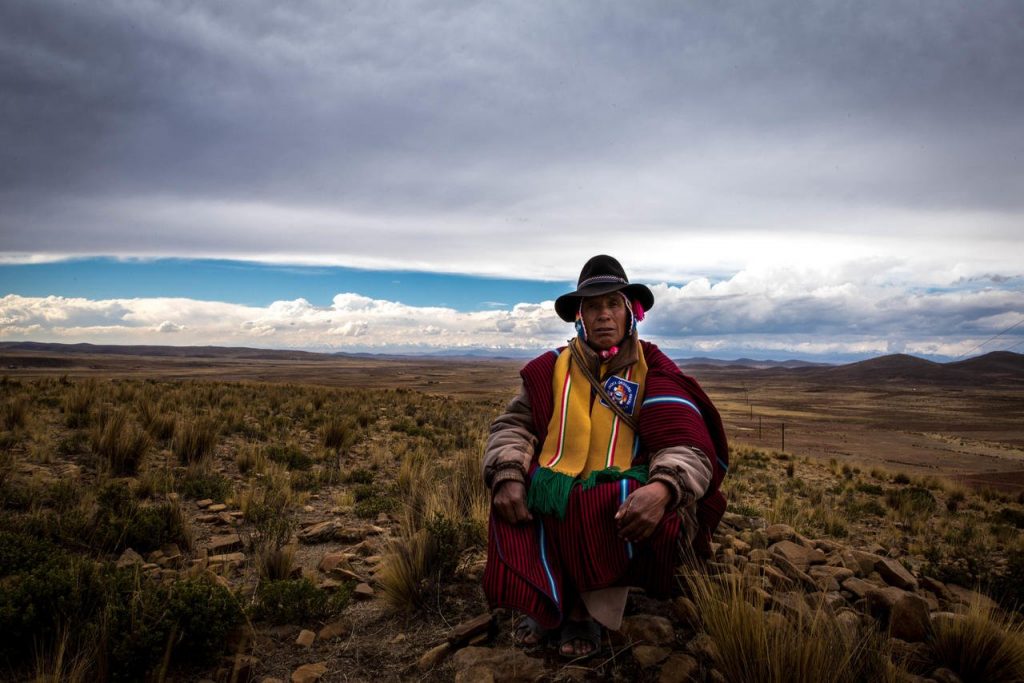
As the Uma Mallku, Sirpa is entitled to wear a red and black poncho, ceremonial instruments, and a dark fedora. In the Aymara society, Mallkus are rotating positions that ensure the proper functioning of the community.
In 1990, less than half of the Bolivian population had water at home. Evo Morales, the current president of Bolivia, remembers well the days of thirst; he is, like Sirpa, a son of Aymara peasants and spent his early childhood in the high Andean plateau. He was born one kilometer away from a water well and his mother had to walk every day to bring water home. That may explain why one of his first acts after he came to power was the creation of a Ministry of Water. He also promoted a resolution at the UN, in 2010, that designated access to safe water and sanitation as an “essential to the full enjoyment of life and all human rights.”
GDP growth (6.8 percent in 2013), the Human Development Index, and the Gini Coefficient tell how Bolivia has progressed under Morales’ rule. However, in his eagerness to exert control, the president changed the head of the Ministry of Water—a precious political position—eight times in three terms. A minister with a technical background, José Antonio Zamora, stayed in office longer than anyone else (2012 – 2015). Although Bolivia has already reached the Millennium Development Goals, Zamora says that “much remains to be done,” especially in rural areas.
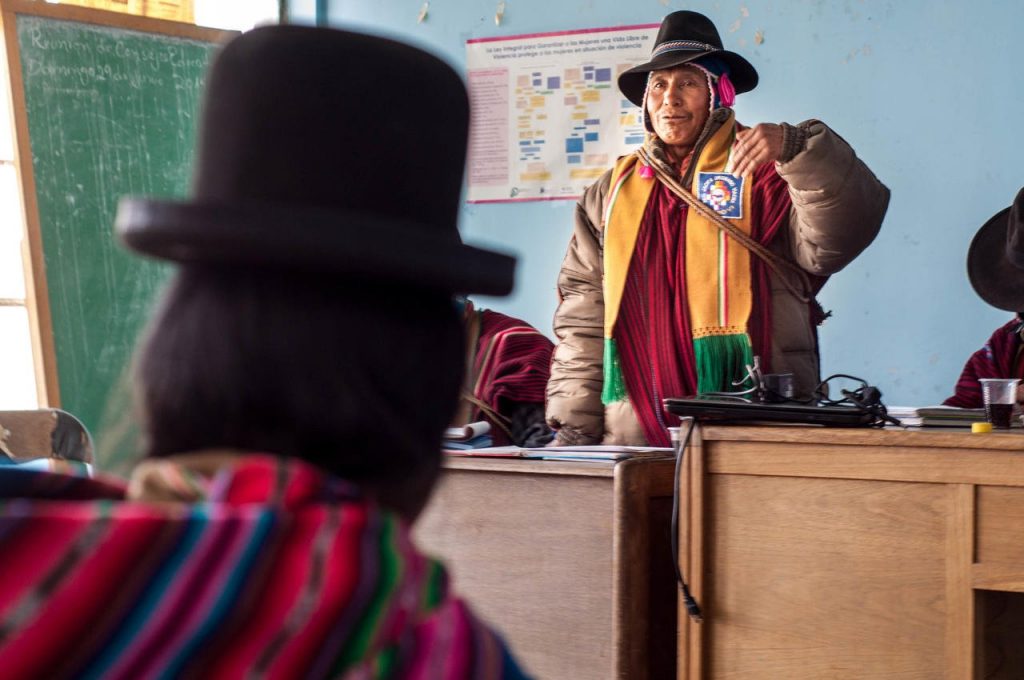
Since Evo Morales took office in 2005, water has been a main issue in Bolivia’s politics. Despite that, almost two million people still live without access to a reliable source of water. Here, Sirpa attends a meeting with leaders from other communities to speak about water scarcity.
“The president created the Agenda 2025, which sets specific targets for the elimination of extreme human poverty and coverage of basic services, including obviously water and sanitation,” Zamora explains. In 2025, Bolivia will turn 200 as an independent country and, to commemorate the Bicentennial, Morales’ government created a comprehensive development program. However, some of its points clash directly with Bolivia’s economic model, which is based in the exploitation of its natural resources.
Sirpa, the quiet Andean peasant, admires “el Evo,” as he calls him, but his life has not improved substantially in the nine years Morales has been leading the country. Two of the neighboring towns, Achica Arriba and Achica Baja, recently built new drinking water distribution systems with money given by NGOs and international development agencies. Now people from Central Coniri look at their nearby countrymen with envy. That’s why Sirpa keeps on walking through the wasteland, carrying blueprints and documents. He has to control, along with the members of his community, the advances on the well they are digging.
***
Jacinto Sirpa Condori sits on the ground, surrounded by his neighbors in the shade of a huge blue drill. Women lay down and open their multicolored blankets to prepare the feast. People from Central Coniri have gathered for an “apthapi,” an Aymara tradition of meeting and sharing. Everybody has brought a little something: there are boiled and freeze-dried potatoes, beans, yucca, fried fish, cheese, chili peppers and llama meat.
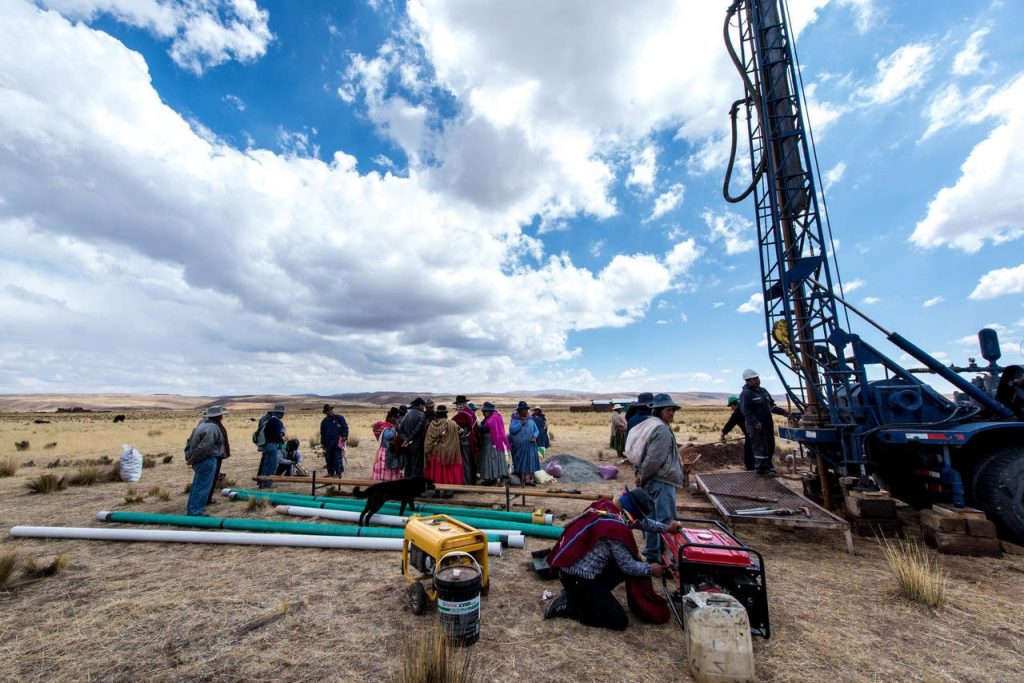
In the shadow of a drill, people from Central Coniri gather for an “apthapi,” an Aymara tradition of meeting and sharing. Everybody has brought something to share; beans, yucca, fried fish and even llama meat.
On the horizon glows the snow of the glaciers, topping 20,000 feet-high peaks. Sirpa pays attention to the people around him and patiently meets their demands. “We are drilling down to one hundred feet and there is water,” he announces, smiling. “There is water!”
Michele, Felix and Javier worked on “Bolivia’s Everyday Water War,” an interactive documentary that follows the struggle in the Andean country to improve water access and sanitation. Bolivia’s Everyday Water War is funded by the Bill & Melinda Gates Foundation through the Innovation in Development Reporting Grant Program, a media-funding project operated by the European Journalism Center). https://www.facebook.com/bewwdoc; Twitter @beww_en.
More from Narratively
The Plot Against the Principality of Sealand
This article was originally published on August 25, 2015, by Narratively, and is republished here with permission.
Diverse human stories, just for you.
For more information please visit the following link:
https://getpocket.com/explore/item/22-000-days-without-drinking-water?utm_source=pocket-newtab
Bring Back Handwriting: It’s Good for Your Brain
People are losing the brain benefits of writing by hand as the practice becomes less common
Markham Heid Sep 12 · 4 min read
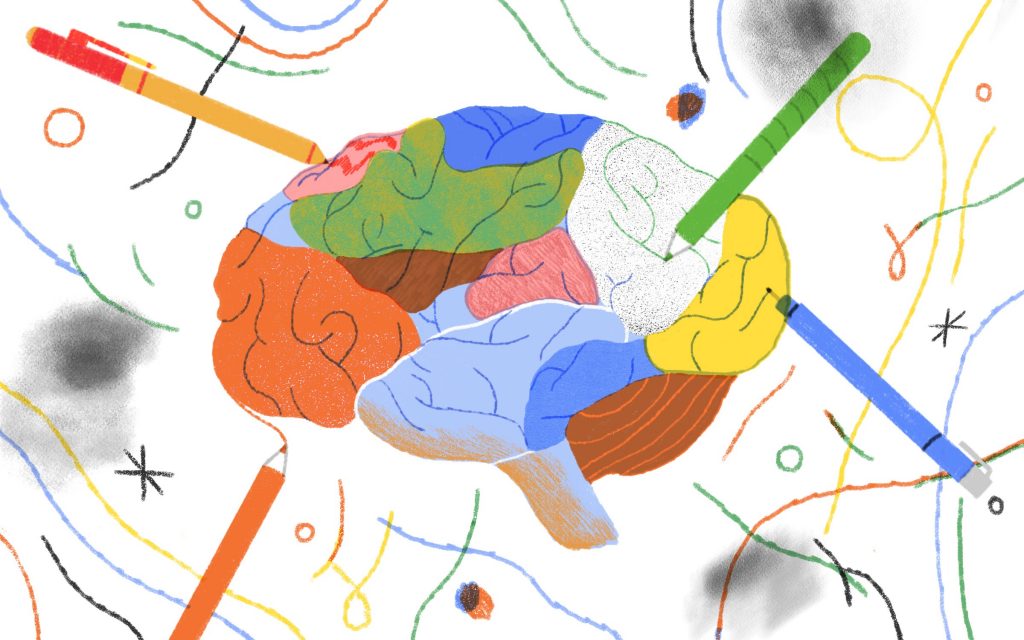
Illustration: Kieran Blakey
Not so long ago, putting pen to paper was a fundamental feature of daily life. Journaling and diary-keeping were commonplace, and people exchanged handwritten letters with friends, loved ones, and business associates.
While longhand communication is more time-consuming and onerous, there’s evidence that people may in some cases lose out when they abandon handwriting for keyboard-generated text.
Psychologists have long understood that personal, emotion-focused writing can help people recognize and come to terms with their feelings. Since the 1980s, studies have found that “the writing cure,” which normally involves writing about one’s feelings every day for 15 to 30 minutes, can lead to measurable physical and mental health benefits. These benefits include everything from lower stress and fewer depression symptoms to improved immune function. And there’s evidence that handwriting may better facilitate this form of therapy than typing.
A commonly cited 1999 study in the Journal of Traumatic Stress found that writing about a stressful life experience by hand, as opposed to typing about it, led to higher levels of self-disclosure and translated to greater therapeutic benefits. It’s possible that these findings may not hold up among people today, many of whom grew up with computers and are more accustomed to expressing themselves via typed text. But experts who study handwriting say there’s reason to believe something is lost when people abandon the pen for the keyboard.
Psychologists have long understood that personal, emotion-focused writing can help people recognize and come to terms with their feelings.
“When we write a letter of the alphabet, we form it component stroke by component stroke, and that process of production involves pathways in the brain that go near or through parts that manage emotion,” says Virginia Berninger, a professor emerita of education at the University of Washington. Hitting a fully formed letter on a keyboard is a very different sort of task — one that doesn’t involve these same brain pathways. “It’s possible that there’s not the same connection to the emotional part of the brain” when people type, as opposed to writing in longhand, Berninger says.
Writing by hand may also improve a person’s memory for new information. A 2017 study in the journal Frontiers in Psychology found that brain regions associated with learning are more active when people completed a task by hand, as opposed to on a keyboard. The authors of that study say writing by hand may promote “deep encoding” of new information in ways that keyboard writing does not. And other researchers have argued that writing by hand promotes learning and cognitive development in ways keyboard writing can’t match.
The fact that handwriting is a slower process than typing may be another perk, at least in some contexts. A 2014 study in the journal Psychological Science found that students who took notes in longhand tested higher on measures of learning and comprehension than students who took notes on laptops.
“The primary advantage of longhand notes was that it slowed people down,” says Daniel Oppenheimer, co-author of the study and a professor of psychology at Carnegie Mellon University. While the students who typed could take down what they heard word for word, “people who took longhand notes could not write fast enough to take verbatim notes — instead they were forced to rephrase the content in their own words,” Oppenheimer says. “To do that, people had to think deeply about the material and actually understand the arguments. This helped them learn the material better.”
Slowing down and writing by hand may come with other advantages. Oppenheimer says that because typing is fast, it tends to cause people to employ a less diverse group of words. Writing longhand allows people more time to come up with the most appropriate word, which may facilitate better self-expression. He says there’s also speculation that longhand note-taking can help people in certain situations form closer connections. One example: “A doctor who takes notes on a patient’s symptoms by longhand may build more rapport with patients than doctors who are typing into a computer,” he says. Also, a lot Berninger’s NIH-funded work found that learning to write first in print and then in cursive helps young people develop critical reading and thinking skills.
Finally, there’s a mountain of research that suggests online forms of communication are more toxic than offline dialogue. Most of the researchers who study online communication speculate that a lack of face-to-face interaction and a sense of invisibility are to blame for the nasty and brutish quality of many online interactions. But the impersonal nature of keyboard-generated text may also, in some small way, be contributing to the observed toxicity. When a person writes by hand, they have to invest more time and energy than they would with a keyboard. And handwriting, unlike typed text, is unique to each individual. This is why people usually value a handwritten note more highly than an email or text, Berninger says. If words weren’t quite so easy to produce, it’s possible that people would treat them — and maybe each other — with a little more care.
Elemental Your life, sourced by science. A new Medium publication about health and wellness.
For more information please visit the following link:
https://elemental.medium.com/bring-back-handwriting-its-good-for-your-brain-fe22fe6c81d2
Pocket Worthy
·Physics Explains Why Time Passes Faster As You Age
Mind time cannot be measured on a watch.
Quartz | Ephrat Livni

Photo by Sergei Karpukhin.
Mind time and clock time are two totally different things. They flow at varying rates.
The chronological passage of the hours, days, and years on clocks and calendars is a steady, measurable phenomenon. Yet our perception of time shifts constantly, depending on the activities we’re engaged in, our age, and even how much rest we get. An upcoming paper in the journal European Review by Duke University mechanical engineering professor Adrian Bejan, explains the physics behind changing senses of time and reveals why the years seem to fly by the older we get. (The paper, sent to Quartz by its author, has been peer-reviewed, edited, and has been approved for publication but a date has not yet been set.)
Bejan is obsessed with flow and, basically, believes physics principles can explain everything. He has written extensively about how the principles of flow in physics dictate and explain the movement of abstract concepts, like economics. Last year, he won the Franklin Institute’s Benjamin Franklin Medal for “his pioneering interdisciplinary contributions…and for constructal theory, which predicts natural design and its evolution in engineering, scientific, and social systems.”
In his latest paper, he examines the mechanics of the human mind and how these relate to our understanding of time, providing a physical explanation for our changing mental perception as we age.
The Mind’s Eye
According to Bejan—who reviewed previous studies in a range of fields on time, vision, cognition, and mental processing to reach his conclusion—time as we experience it represents perceived changes in mental stimuli. It’s related to what we see. As physical mental-image processing time and the rapidity of images we take in changes, so does our perception of time. And in some sense, each of us has our own “mind time” unrelated to the passing of hours, days, and years on clocks and calendars, which is affected by the amount of rest we get and other factors. Bejan is the first person to look at time’s passage through this particular lens, he tells Quartz, but his conclusions rest on findings by other scientists who have studied physical and mental process related to the passage of time.
These changes in stimuli give us a sense of time’s passage. He writes:
The present is different from the past because the mental viewing has changed, not because somebody’s clock rings. The “clock time” that unites all the live flow systems, animate and inanimate, is measurable. The day-night period lasts 24 hours on all watches, wall clocks and bell towers. Yet, physical time is not mind time. The time that you perceive is not the same as the time perceived by another.
Time is happening in the mind’s eye. It is related to the number of mental images the brain encounters and organizes and the state of our brains as we age. When we get older, the rate at which changes in mental images are perceived decreases because of several transforming physical features, including vision, brain complexity, and later in life, degradation of the pathways that transmit information. And this shift in image processing leads to the sense of time speeding up.
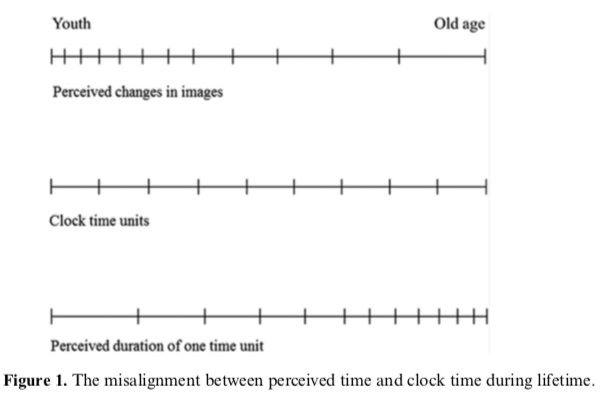
Clock time and mind time over a lifetime. From Adrian Bejan.
This effect is related to saccadic eye movement. Saccades are unconscious, jerk-like eye movements that occur a few times a second. In between saccades, your eyes fixate and the brain processes the visual information it has received. All of this happens unconsciously, without any effort on your part. In human infants, those fixation periods are shorter than in adults.
There’s an inversely proportional relationship between stimuli processing and the sense of time speeding by, Bejan says. So, when you are young and experiencing lots of new stimuli—everything is new—time actually seems to be passing more slowly. As you get older, the production of mental images slows, giving the sense that time passes more rapidly.
Fatigue also influences saccades, creating overlaps and pauses in these eye movements that lead to crossed signals. The tired brain can’t transfer the information effectively when it’s simultaneously trying to see and make sense of the visual information. It’s designed to do these things separately.
This is what leads to athletes’ poor performance when exhausted. Their processing powers get muddled and their sense of timing is off. They can’t see or respond rapidly to new situations.
Another factor in time’s perceived passage is how the brain develops. As the brain and body grow more complex and there are more neural connections, the pathways that information travels are increasingly complicated. They branch like a tree and this change in processing influences our experience of time, according to Bejan.
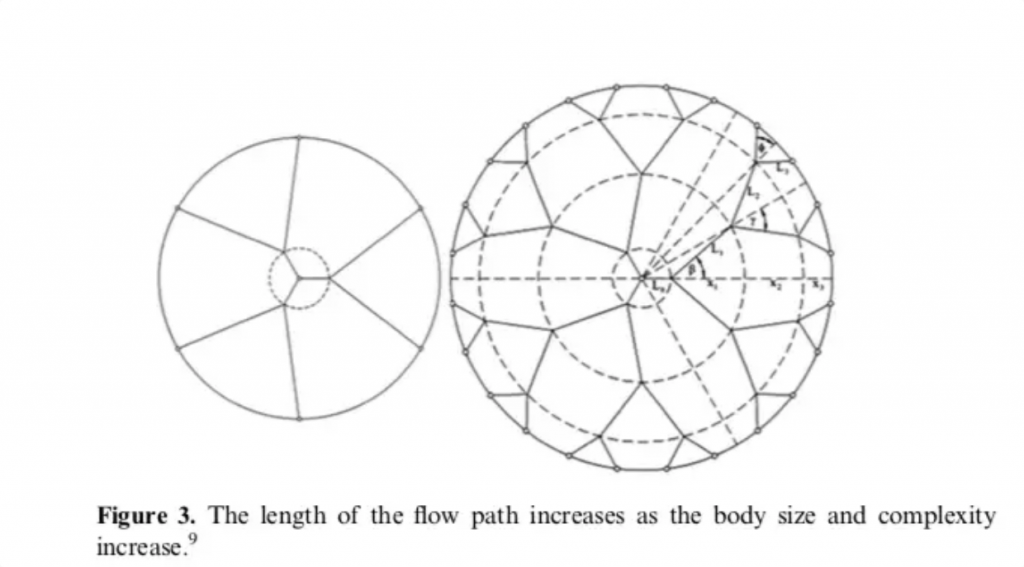
The brain’s complexity changes our sense of time. From Adrian Bejan.
Finally, brain degradation as we age influences perception. Studies of saccadic eye movements in elderly people show longer latency periods, for example. The time in which the brain processes the visual information gets longer, which makes it more difficult for the elderly to solve complex problems. They “see” more slowly but feel time passing faster, Bejan argues.
A Lifetime to Measure By
Bejan became interested in this topic more than a half century ago. As a young athlete on a prestigious Romanian basketball team, he noticed that time slowed down when he was rested and that this enabled him to perform better. Not only that, he could predict team performance in a game based on the time of day it was scheduled. He tells Quartz:
Early games, at 11 a.m., were poor, a killer; afternoon and evening games were much better. At 11 AM we were sleepwalking, never mind what each of us did during the night. It became so clear to me that I knew at the start of the season, when the schedule was announced, which games will be bad. Games away, after long trips and bad sleep were poor, home games were better, for the same reason. In addition, I had a great coach who preached constantly that the first duty of the player is to sleep regularly and well, and to live clean.
Now he’s experienced how “mind time” changes over the much longer span of his whole life. “During the past 20 years I noticed how my time is slipping away, faster and faster, and how I am complaining that I have less and less time,” he says. It’s a sentiment he hears echoed by many around him.
Still, he notes, we’re not entirely prisoners of time. The clocks will continue to tick strictly, days will go by on the calendar, and the years will seem to fly by ever faster. By following his basketball coach’s advice—sleeping well and living clean—Bejan says we can alter our perceptions. This, in some sense, slows down mind time.
This article was originally published on January 8, 2019, by Quartz, and is republished here with permission.
For more information please visit the following link:
What’s it like to grow up within a group of people who exult in demonizing … everyone else? Megan Phelps-Roper shares details of life inside America’s most controversial church and describes how conversations on Twitter were key to her decision to leave it. In this extraordinary talk, she shares her personal experience of extreme polarization, along with some sharp ways we can learn to successfully engage across ideological lines.
This talk was presented at an official TED conference, and was featured by our editors on the home page.
About the speaker
Megan Phelps-Roper · Writer, activist
Take Action
participate
Be deliberate about cultivating empathy for “enemies.” Before getting into a conversation full of intense disagreement, you can lay the groundwork for success by making deliberate efforts to understand the perspective of groups with ideas you oppose. Whether Republicans or Democrats, city-dwellers or rural farmers, consider the groups you tend to write off. Who are they? Given their experiences, can you understand why they hold the positions they do? What ideas do you share? When you’re intentional about searching for understanding and common ground, you’ll be better at engaging people with opposing ideas on the merits — instead of the mental caricatures humans often form of one another.
volunteer
Practice engaging when the stakes are low. Remember that the strategies mentioned in this talk aren’t natural; they’re skills we have to learn and develop in ourselves. Disagreements are common, but the more intense the disagreement, the harder it is to remain calm enough to engage effectively. To practice, be on the lookout for low-stakes disagreements that appear in your life. Answering an angry tweet from a stranger requires less time and emotional energy than staying cool in a long conversation with a close friend about a divisive subject. Reaching out when the stakes are low strengthens our ability to engage when stress levels and potential costs are higher.
How can the US recover after the negative, partisan presidential election of 2016? Social psychologist Jonathan Haidt studies the morals that form the basis of our political choices. In conversation with TED Curator Chris Anderson, he describes the patterns of thinking and historical causes that have led to such sharp divisions in America — and provides a vision for how the country might move forward.
This talk was presented at an official TED conference, and was featured by our editors on the home page.
About the speakers
Jonathan Haidt · Social psychologist
Jonathan Haidt studies how — and why — we evolved to be moral and political creatures.
More Resources
Further reading
CivilPolitics.org educates groups and individuals who are trying to bridge moral divisions by connecting them with scientific research into the political domain.
Further reading
HeterodoxAcademy.org is politically diverse group of social scientists, natural scientists, humanists, and other scholars who share a concern about a growing problem: the loss or lack of “viewpoint diversity.”
More at heterodoxacademy.org ?
Further reading
EthicalSystems.org makes the world’s best research available and accessible, for free, to anyone interested in improving the ethical culture and behavior of an organization.
An Incredible Aerial Tour of Earth’s Surface from the International Space Station
January 9, 2019 Laura Staugaitis
Philadelphia-based photographer and videographer Bruce W. Berry Jr. brings together images from the International Space Station (ISS) in his new time-lapse video, The World Below. Berry used public content from NASA to form the meditative short film that reads like a supersized version of today’s popular drone landscape videos. The World Below offers a glimpse at the vast scale of our planet, with portions of the ISS in-frame to provide additional perspective. The film compares richly textured, abstracted topography with dense networks of bright lights to showcase the powerful impact of humans on the planet.
All video and time-lapse sequences were taken by astronauts onboard the ISS. Berry then edited, color graded, denoised, and stabilized the footage to create the seamless quality of the final film. If you’re interested to learn the specifics of the clips’ locations, the filmmaker lists them out to the best of his knowledge in the video notes.
Berry created a similar video in 2013, but decided to create the newer version due to the wealth of content that has become available since his original take. The ISS makes 14.54 orbits around the Earth every day, providing ample opportunity for new views. You can see more of Berry’s photography portfolio on his website, and watch more videos on his Vimeo channel. (via Vimeo Staff Picks)




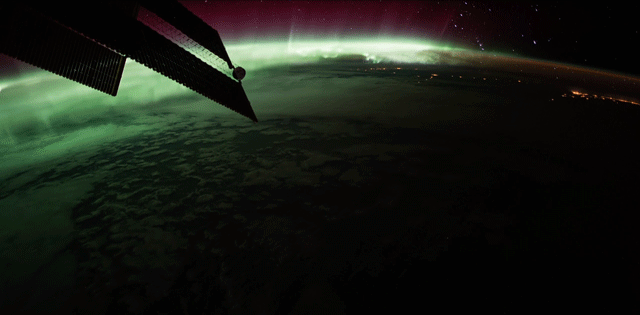
Fantastical Photographs of Opulently Dressed Models in Castles and Mansions

“Swan Lake” (2014), all images © Natalie Lennard
Photographer Natalie Lennard, who works as Miss Aniela, creates lavish scenes centered around elegantly dressed models. While each image might seem, at first glance, like a straightforward luxury fashion shoot, further inspection reveals surreal details. A canary yellow tulle gown morphs into birds, and ocean water splashes out of a painting frame.
Miss Aniela’s fantastical scenes are created using a combination of on-site shoots with practical effects, along with extensive post-production and even bespoke C.G.I. (as for the 20,000 fish forming the dress worn by a deep sea diver model in “She Shoal”). The photographer explains that all images are shot on location with the model posed and lit in-frame. “Sometimes I do not know whether the image will be largely ‘raw’ and not require overt surrealism added,” Aniela shares, “until I go through the process to feel what is right for each piece.”
The U.K.-based artist has been working as a fine art photographer for 13 years, getting her start with self-portraits as a university student. In some works, she incorporates direct references to paintings from the art historical canon. Aniela has been working in her current style since 2011, and shares with Colossal that she has noticed a rising interest in her work from art collectors, as the lines between fine art and fashion are increasingly blurred.
You can explore more of Miss Aniela’s immersive worlds on Instagram, and go behind the scenes of production in her explanatory blog posts. Fine art prints are available via Saatchi Art.

“What He Bequeathed” (2016)
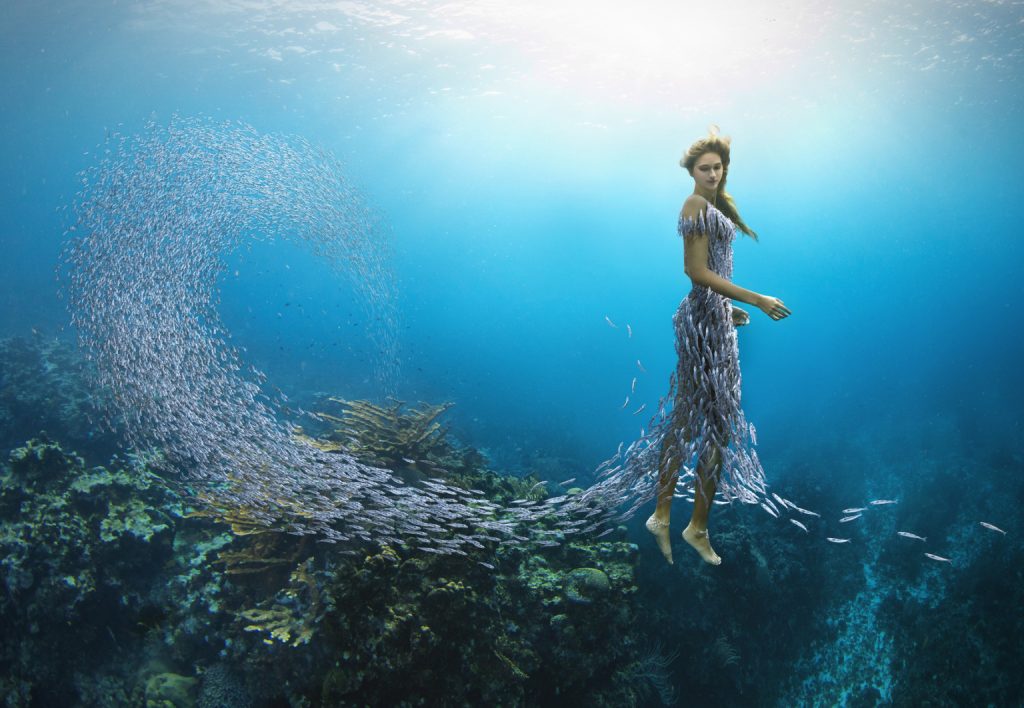
“She Shoal” (2019)

“Poster & Plumage” (2016)

“Enter the Golden Dragon” (2018)

“Thawed Fortress” (2015)

“Gilt” (2016)

“Scarlet Song” (2013)

“Away with the Canaries” (2013)

“Pokerface” (2015)
Ing’s Peace Project
Finished “Peace” artwork 3
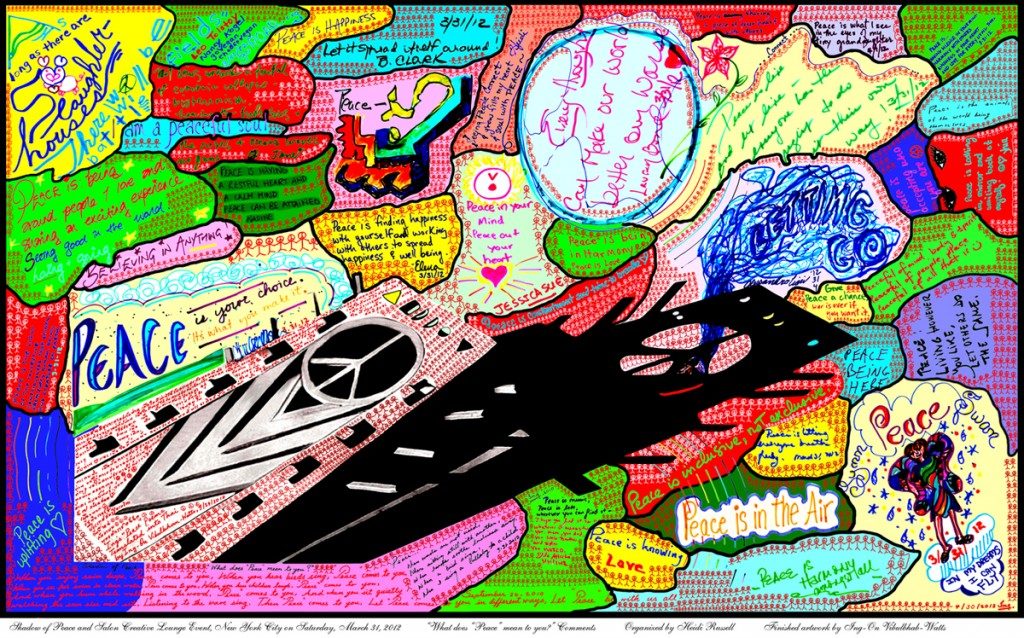
Salon Creative Lounge Event, presented by the International Women Artist’ salon,154 Stanton Street at Suffolk, New York City, NY, on March 31, 2012, organized by Heidi Russell. Finished artwork, after the written comments by Ing-On Vibulbhan-Watts
Link to Peace Project Comes to Salon Creative Lounge NYC Page:
Leave a Reply